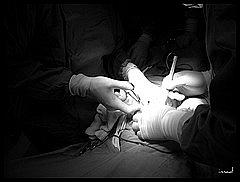Shadow Practice: Surgery center where patient died survived on painkiller scheme

The new filing by the U.S. Drug Enforcement Agency against Dr. Scott Bickman for his role in a painkiller mill reveals a very sad truth. Maria Garcia's death could almost certainly have been avoided.
Antidote wrote about Garcia in September. The 39-year-old died after back-to-back cosmetic surgery procedures at Hills Surgical Center, also known as Anaheim Hills Surgery Center, on March 13, 2008. Without Bickman's help, the surgery center likely would not have had the anesthesia drugs it needed to perform surgeries.
Dr. Lawrence Hansen did not meet Garcia before the surgery or perform a pre-operative exam, according to the Medical Board of California. Garcia was put under general anesthesia, at Hansen's direction. During the first procedure, her vaginal wall was punctured and she eventually bled to death while undergoing the section procedure, a liposuction performed by Dr. Harrell Robinson.
At the time of Garcia's surgeries, Hills Surgical had no accreditation as an outpatient surgery center from the Joint Commission, the main accrediting body for health facilities. That accreditation had expired in 2007.
Bickman told the DEA that, because he was on probation with the Medical Board of California following a patient's death, he stopped performing anesthesia at Hills Surgical. The state "prohibited him from practicing at an unaccredited facility and that he had stopped going there," DEA Administrator Michele M. Leonhart wrote.
But Bickman did not stop helping Robinson buy painkillers and other drugs. He took $2,000 a month from Robinson in exchange for allowing Robinson to use Bickman's DEA registration to buy drugs. Bickman had another money angle, too. He offered to help the surgery center become accredited with another organization, the Institute for Medical Quality. All it would take is $16,000, he said, according to the DEA. Bickman "knew a nurse anesthetist who had previously assisted other surgery centers in obtaining accreditation and who would provide him with the templates necessary to prepare the documents required to do so," Leonhart wrote.
Bickman told the DEA that he let Robinson use his DEA registration to order drugs because the surgery center "was required to have stocks of anesthesia drugs on hand prior to obtaining re-accreditation." Leonhart did not buy this, writing, ""Given [Bickman's] statements that the center ‘was not legally performing surgery,' Robinson had no lawful need to order any controlled substances."
Bickman's agreement to let Robinson use his DEA registration was so crucial to the survival of Anaheim Hills Surgery Center that when his DEA registration expired, both Robinson and his wife, Alinka Robinson, began "calling incessantly asking why it hadn't been renewed," Bickman told the DEA, adding that it became "a state of almost panic for us to get it done. Alinka was blowing up the phone night and day, ‘Where's my renewal?'"
Bickman's help paid off. The surgery center stayed in business. Robinson continued earning $10,000 a month from the shadowy Madre Maria Ines Teresa Health Center for providing painkillers. He continued ordering drugs using Bickman's license and Dr. Thomas Mitchell's license. And he continued performing surgeries despite the center's lack of accreditation.
Without Bickman's help, there is a good chance that Garcia would be alive.
The surgery center was accredited by the Joint Commission in August 2008, five months after Garcia died during a surgery that should have never happened. It was accredited again in July 2010.
Two months after Antidote wrote about Garcia's death and all of the other problems at Anaheim Hills Surgery Center, the Joint Commission visited the center again. It had a slight change of heart this time. It revoked the surgery center's full accreditation and instead gave it a "conditional accreditation," listing a range of factors.
None of these factors, however, have to do with deaths at the center or drugs being illegally bought and sold through the center.
Comment or question? Send it to askantidote@gmail.com. You also can follow Antidote on Twitter @wheisel.
Related Posts:
The Shadow Practice: Disciplined doctor found an exile community in immigrant health care
The Shadow Practice Part 2: New owners can't exorcise ghosts of clinic's past
The Shadow Practice Part 3: Immigrant clinic had deep roots in deception
The Shadow Practice Part 4: Doc begs patients for loans
The Shadow Practice Part 5: Drug pushers running this clinic were far from saints
The Shadow Practice Part 6: Doctors sell their souls, and their licenses, on the cheap
The Shadow Practice Part 7: Punishment for drug-dealing doctors more severe in Arizona
The Shadow Practice Part 8: How one California clinic became a magnet for bad medicine
The Shadow Practice Part 9: Woman dies during cosmetic surgeries at unlicensed clinic
The Shadow Practice Part 11: Joint Commission overlooks risky practices that led to patient death
The Shadow Practice Part 12: Patient safety net still in tatters three years after court ruling
Shadow Practice Update: Doctor who sold prescribing license on the cheap finally pays price
California governor and medical board should stand accused in patient's death
Andrew Rutland: California doctor accused in repeated patient deaths surrenders license
Photo credit: ImadCode via Flickr

